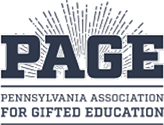Students who are gifted and talented will often spend a majority of their school day in the regular classroom. Gifted students often receive gifted support in the form of pullout programs or other enrichment programs. These programs are often not more than a couple hours a week. It is important to remember that gifted students are gifted at all times of the day and should be appropriately challenged no matter where their education is happening.
Definitions of Differentiation Components:
- Content – the specific information that is to be taught in the lesson/unit/course of instruction.
- Process – how the student will acquire the content information.
- Product – how the student will demonstrate understanding of the content.
- Learning Environment – the environment where learning is taking place including physical location and/or student grouping
To meet the needs of gifted students, school districts will often differentiate instruction. There are many differentiation strategies that districts will often use to meet the needs of gifted students.
Below are some popular strategies:
- Anchor Activities: Provides students with meaningful activities that can be completed independently. May be leveled to students individual needs.
- Activity Menus
- Also known as choice menus.
- Integrate student choice, multiple learning strategies. Menu could be content specific or cross subject.
- Cubing/Think Dots/Tic Tack Toe Boards
- Allows students to think in multiple directions and to differentiate process and product for students with different learning strengths.
- Curriculum Compacting
- A popular model in the gifted world. Allows curriculum to be adjusted or skipped based on prior knowledge. Students received pre-assessment to find out what they already know and what they still need to be taught.
- Independent Study
- Students research topics based on interest. With gifted students, try to use connections to real life problems or situations.
- Learning Centers
- Centers may be permanent or temporary. Could be author study, specific content, etc.
Signs that Differentiation is occurring in the classroom:
- Consistent use of pre-testing.
- Decrease in the frequency of large group activities and increase in the frequency of activities utilizing small flexible groups
- Evidence of advanced content and acceleration opportunities.
- Collaborative effort among teachers, students, and parents.
- Encouragement to complete assignments in alternative environments such as the library, art room or another classroom more conducive to the requirements of the assignment(s).
- Increase use of a variety of materials, community resources, and technological services.
- Learning objectives that vary in depth and breadth.
- Instruction that uses a variety of teaching methods such as inductive, deductive and hands-on strategies
- Use of flexible pacing.
- Use of curriculum compacting, tiered assignments, and parallel curriculum.
- Products that vary in complexity and abstractness.
- Differentiated homework assignments – elimination of drill and practice – based on student’s needs
- Open-ended questioning and assignments – use of Bloom’s Taxonomy to provide challenge.
- Emphasis on higher order thinking skills.
- Use of Learning Contracts.
- Flexible Teacher who is willing to negotiate assignments-one who encourages student self-advocacy.

